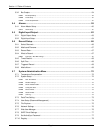
Section 2 - Overview
Page 2 09/11/2008 REV 0.99
Figure 2-1 System Overview
DIGITAL
INPUTS
ANALOG
INPUTS
RELAY
OUTPUTS
MASTER
ENABLE
MASTER
ENABLE
DATA
MANAGER
DIGITAL
INPUT
MANAGER
ALARM
EVENT
MANAGER
DISPLAY &
KEYBOARD
MANAGER
DATA
STORAGE
MANAGER
SYSTEM
MANAGER
USB A/B
RS232/485
AUDIO IO
System Overview
Refer to the figure below:
ALARM MASTER SETUP DISPLAY BUILDER
DIGITAL OUTPUT SETUP ROTATE LIST
ALARM EVENT LOG WIDGET CONTROL
ETHERNET
SYSTEM SECURITY
SYSTEM SETUP
LANGUAGE
DIGITAL INPUT SETUP … .. CONFIGURATION
EMAIL
CHANNEL SETUP MOUSE &
CALIBRATION RECORD SETUP KEYBOARD
FILE EXPLORER
The recorder block diagram shows the major elements of the unit.
The Analog Inputs module scans the live inputs (6 or 12 channel) at a rate of 10 times per second per channel,
converting the analog inputs to digital values and applying a time stamp to the digitized data. The Data Manager
collects this data at a rate of 120 samples per second from the Analog Inputs module and processes it in real
time applying any scaling or linearization as required by user programming, and holds it in a buffer for use by the
rest of the system. This process has the highest priority and runs irrespective of whatever other activity is going
on in the recorder. Data is fed on demand to the following:
Data Storage Manager receives data at a rate set by the user for recording to the media. The media is selected
by the user – compact flash, USB device or internal memory (SD card). The data is buffered till there is a suitable
amount and is then flushed to the selected media.
Display & Keyboard Manager receives data at a rate to satisfy the displays setup by the user, trends, digital or
bar graphs.
Alarm Event Manager receives all data required to do comparison to any user set up alarm. If any alarm is
exceeded the Alarm Event Manager will perform the required user set action, including sounding the alarm,
closing any contacts, updating the display, initiating an email and making an entry in the log.
System Manager receives all data required to keep the various communications servers up to date. This includes
the web, Modbus and OPC servers, and ftp data files.


















